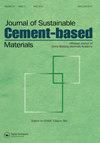Fracture features of calcium carbonate whisker-based composites under freezing and thawing cycles using semi-circular bend test
IF 4.2
3区 工程技术
Q1 CONSTRUCTION & BUILDING TECHNOLOGY
Journal of Sustainable Cement-Based Materials
Pub Date : 2023-04-03
DOI:10.1080/21650373.2022.2066028
引用次数: 0
Abstract
Calcium carbonate whiskers (CW) showed good cracking resistance at the microscale. In this research, four different CW volume fractions (1.0%, 1.5%, 2.0%, and 3.0%) were added into cement mortar. The purpose was to further investigate the fracture behavior by using a semi-circular bend test (SCB) of SCB-CW after different freezing and thawing cycles (0 cycles, 25 cycles, 50 cycles, 75 cycles, and 100 cycles). In addition, three analytical models of SCB-PM and SCB-CW were established to predict the stress-strain response after different freezing and thawing cycles. The experimental results showed that the lowest mass increment, electric flux, highest residual flexural strength, fracture toughness, and fracture energy after different freezing and thawing cycles were observed in SCB-CW3.0. It was observed from the experimental results that only model II completely satisfied its basic requirements and its parameter c was closely correlated with the number of freeze-thaw cycles and the CW volume fraction. Highlights Calcium carbonate whisker is added to enhance the fracture behavior of mortar. The different freezing and thawing cycles are considered. The results are obtained using semi-circular bend test and analytical models are established. The highest fracture parameters are observed in SCB-CW3.0 under different freezing and thawing cycles. The model II is suggested for predicting the experimental response of composites.半圆形弯曲试验研究碳酸钙晶须基复合材料在冻融循环下的断裂特征
碳酸钙晶须(CW)在微观尺度上表现出良好的抗裂性。在本研究中,在水泥砂浆中加入了四种不同的CW体积分数(1.0%、1.5%、2.0%和3.0%)。目的是通过使用SCB-CW在不同冷冻和解冻循环(0个循环、25个循环、50个循环、75个循环和100个循环)后的半圆形弯曲试验(SCB)来进一步研究断裂行为。此外,还建立了SCB-PM和SCB-CW三个分析模型来预测不同冻融循环后的应力-应变响应。实验结果表明,SCB-CW3.0在不同冻融循环后的质量增量、电流量、残余抗弯强度、断裂韧性和断裂能最低。从实验结果可以看出,只有模型II完全满足其基本要求,其参数c与冻融循环次数和CW体积分数密切相关。亮点添加碳酸钙晶须,增强砂浆的断裂性能。考虑了不同的冻融循环。通过半圆形弯曲试验得到了结果,并建立了分析模型。SCB-CW3.0在不同冻融循环下的断裂参数最高。提出了预测复合材料实验响应的模型Ⅱ。
本文章由计算机程序翻译,如有差异,请以英文原文为准。
求助全文
约1分钟内获得全文
求助全文
来源期刊
CiteScore
6.60
自引率
15.90%
发文量
71
期刊介绍:
The Journal of Sustainable Cement-Based Materials aims to publish theoretical and applied researches on materials, products and structures that incorporate cement. The journal is a forum for discussion of research on manufacture, hydration and performance of cement-based materials; novel experimental techniques; the latest analytical and modelling methods; the examination and the diagnosis of real cement and concrete structures; and the potential for improved cement-based materials. The journal welcomes original research papers, major reviews, rapid communications and selected conference papers. The Journal of Sustainable Cement-Based Materials covers a wide range of topics within its subject category, including but are not limited to: • raw materials and manufacture of cement • mixing, rheology and hydration • admixtures • structural characteristics and performance of cement-based materials • characterisation techniques and modeling • use of fibre in cement based-materials • degradation and repair of cement-based materials • novel testing techniques and applications • waste management

 求助内容:
求助内容: 应助结果提醒方式:
应助结果提醒方式:


